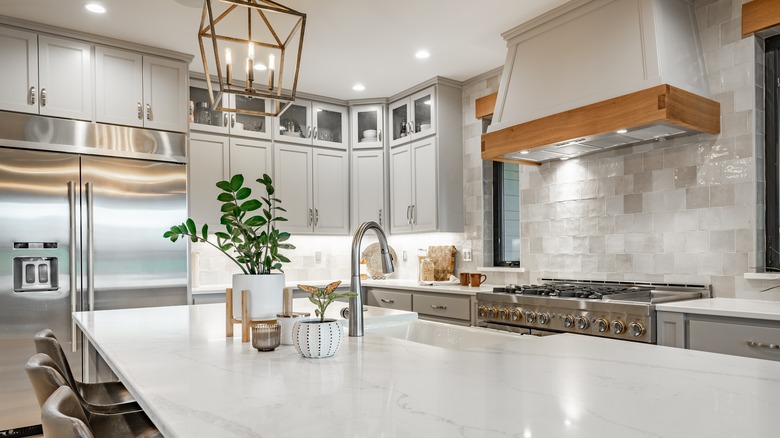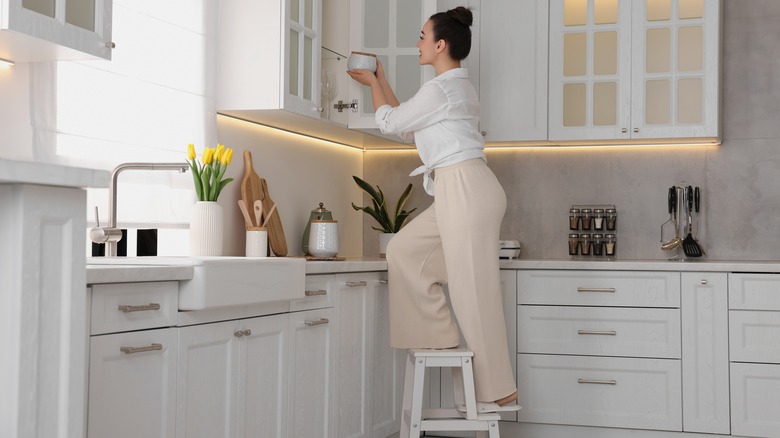Why You May Want To Reconsider To-The-Ceiling Kitchen Cabinets
Cabinets are a main element in the kitchen. They might not seem as special as stone countertops or shiny appliances, but cabinetry sets the stage for your space, and the kitchen wouldn't be complete without them. Typical wall-hung cabinets sit a foot or two below the ceiling, but many home renovators are now opting to embrace the recent trend of to-the-ceiling cabinets. However, swapping out your standard cupboards for these tall versions can be a design mistake. These sky-high pieces come at a high price, and they can limit the practicality of your kitchen.
Kitchen cabinets flush with the ceiling seem like a great upgrade to the traditional cupboard. They can draw eyes upwards to make the ceiling appear larger and maximize storage space. Plus, there's no awkward gap to fill or space for dust to collect. Despite that, there is a reason kitchen cabinets don't go up to the ceiling. It is not a matter of style, but functionality. Getting rid of your standard cabinetry for the taller version can hurt the kitchen's flow and performance. Instead, you may want to embrace the gap.
The cons of to-the-ceiling kitchen cabinets
To-the-ceiling kitchen cabinets are visually appealing, but they aren't practical. The idea of more storage space is desirable, but in reality, shelving that is 8 feet above the ground and higher is not accessible. Especially if you have high ceilings, you will need to bring out the step stool or ladder just to reach any goods you have stored on the top shelves. On the other hand, tall cabinets might seem like a way to make a small kitchen appear bigger, but they actually can overwhelm the compact room and make the space feel cramped.
Plus, this pantry style can be costly. You will need large or extra tall cupboards to fill the space, which will be more expensive than the standard models. If one set of cupboards still leaves a gap between the ceiling, you may need stacked cabinets, where two rows of cupboards are mounted on top of each other. That doubles the number of upper wall cabinets you need for the kitchen. In the end, opting for ceiling-height cabinetry can leave you with expensive shelving you can't reach. Fortunately, there are alternatives to avoid these two issues and get the kitchen you desire.
Alternatives for impractical to-the-ceiling kitchen cabinets
If your heart is set on cabinets that are flush with the ceiling, you can eliminate the concerns of cost and inaccessible shelving with a DIY. This project allows you to extend your kitchen cabinets to the ceiling on a budget, but it is with a faux cupboard, so you won't create impractical storage. Further, you can remove the extension without damaging your wall-hung cabinets when you're ready to switch things up. In essence, you'll box off the gap between the cabinet and ceiling with plywood and paint it to match the cabinets.
Instead of mock to-the-ceiling kitchen cabinets, you can stick to the standard cupboards and decorate the empty space to tie everything together. By adding ornamental pieces, you'll have an intentional design without impractical storage, expensive tall cupboards, or having to build extensions. There are various items you can use to decorate depending on your kitchen's aesthetic. Faux plants are a stellar option for something natural-ish, decor like wooden cutting boards, signage, and jars of spices are ideal for a rustic look, while glass vases lean on the modern side. Think of it like styling a bookshelf. You'll add personality to your kitchen without having a remodel you'll regret.


